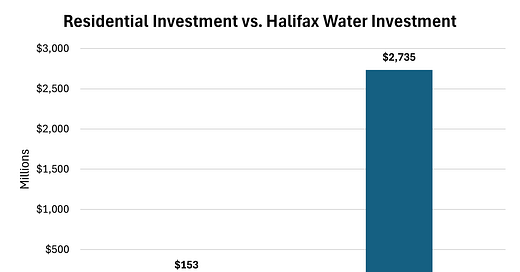Repost: "A small tail wagging a very big dog"
Deny Sullivan: housing costs are much, much larger than water/sewer costs
A common objection to building more housing: what if there isn't enough water or sewer capacity in the neighbourhood?
Deny Sullivan argues that it doesn't make sense to block new housing because of the cost of adding water and sewer capacity. Don’t let Halifax Water block housing:
Last year, Halifax Water invested $153 million in new pipes and equipment. But total residential construction investment in Halifax was $2.74 billion.
If Halifax Water doubled its capital investment, enabling even a ~5% increase in residential investment would put the city in a better place economically. But it would lead to bad media articles and complaints - so Halifax Water continues focusing on its largely irrelevant finances.
Restricting investment in new water/sewer capacity to save money on monthly water bills, resulting in higher rents, is being penny-wise and pound-foolish.
Similarly, the total capital budget for the Metro Vancouver Regional District is about $600 million annually; total residential investment in Metro Vancouver is about $10 billion annually.




It's a bit more complicated than that, and I can put you on to the guy who worked those calcs for Calgary, if you're interested.
The local distribution pipes are a part of the development itself, same as the roads: included in the cost of the developed buildings.
The City comes in when the pipes need to be replaced, many decades later.
But it also comes in when the city grows beyond the size of the feedermains (0.5m+ in diameter. the biggest 2m+, that cost $10/mm to put in.) overall capacity.
You can't go one more mile outward, without running out of water closer in. So then you have to enlarge or twin the major arteries to get enough water out to the new fringe. The added mile requires ten miles of feedermain to enable.
THAT can be very expensive indeed, and putting the cost onto developers would stop development. So Calgary went into debt. A long way into debt, and THAT's when Calgary, even Calgary, started to look more seriously at density. And water conservation. (Finally got meters.)
This issue can be avoided by finding new water sources further out, and building a new water treatment plant on them, basically treating the growth area as a whole new town. All of these issues can vary dramatically depending on local water availability (Calgary is a semi-arid climate with the whole river spoken for).